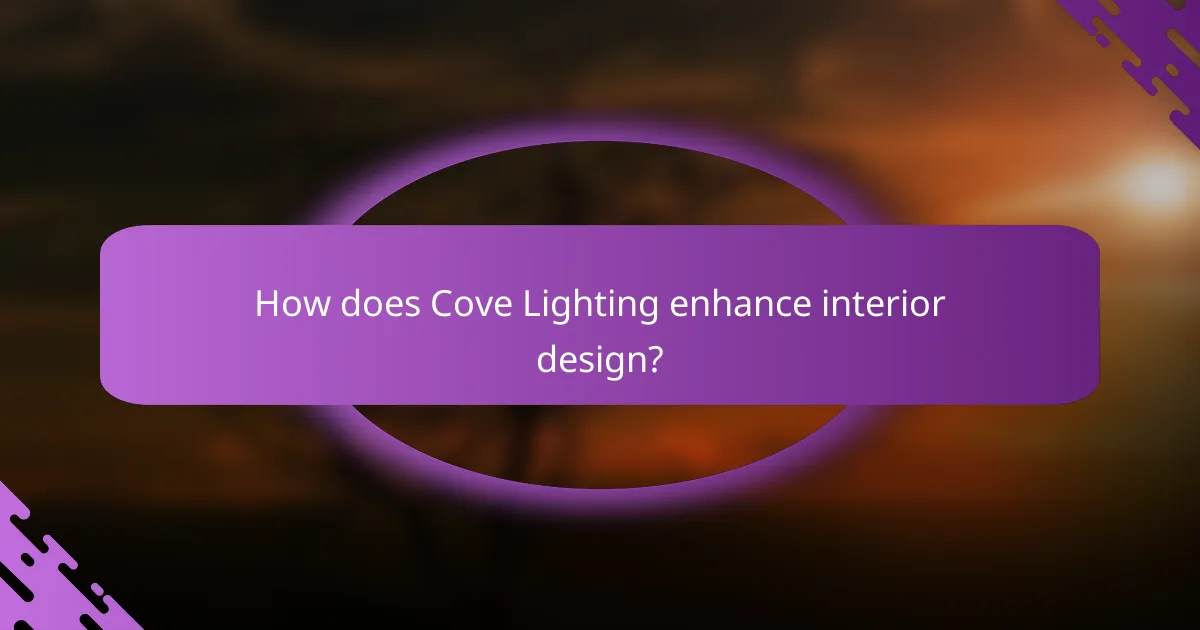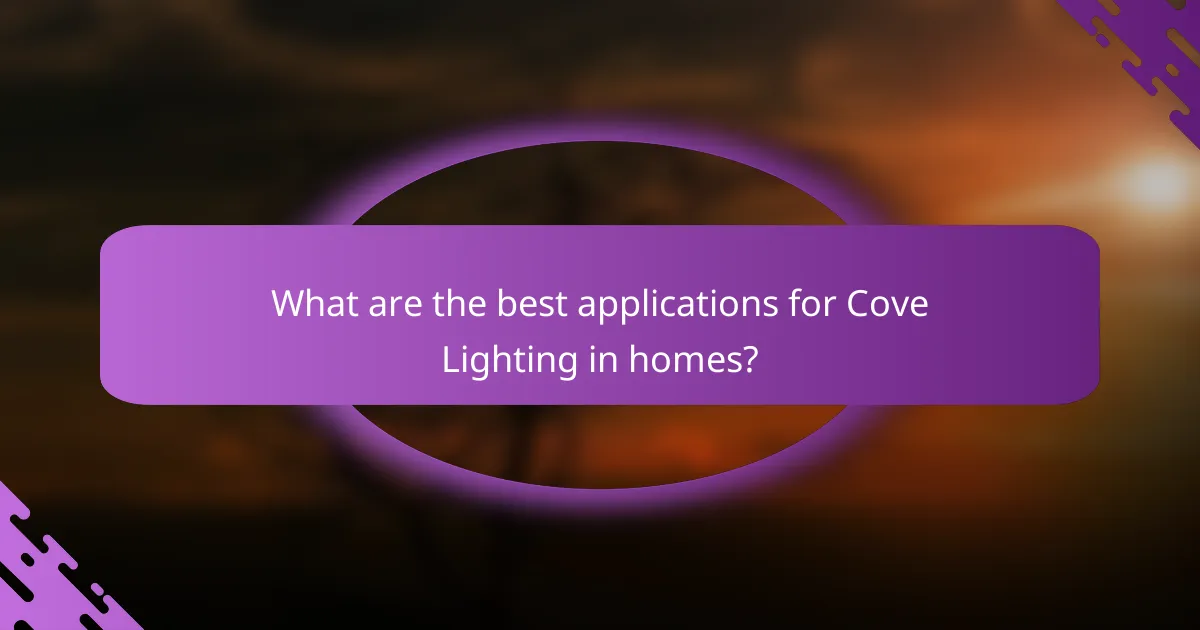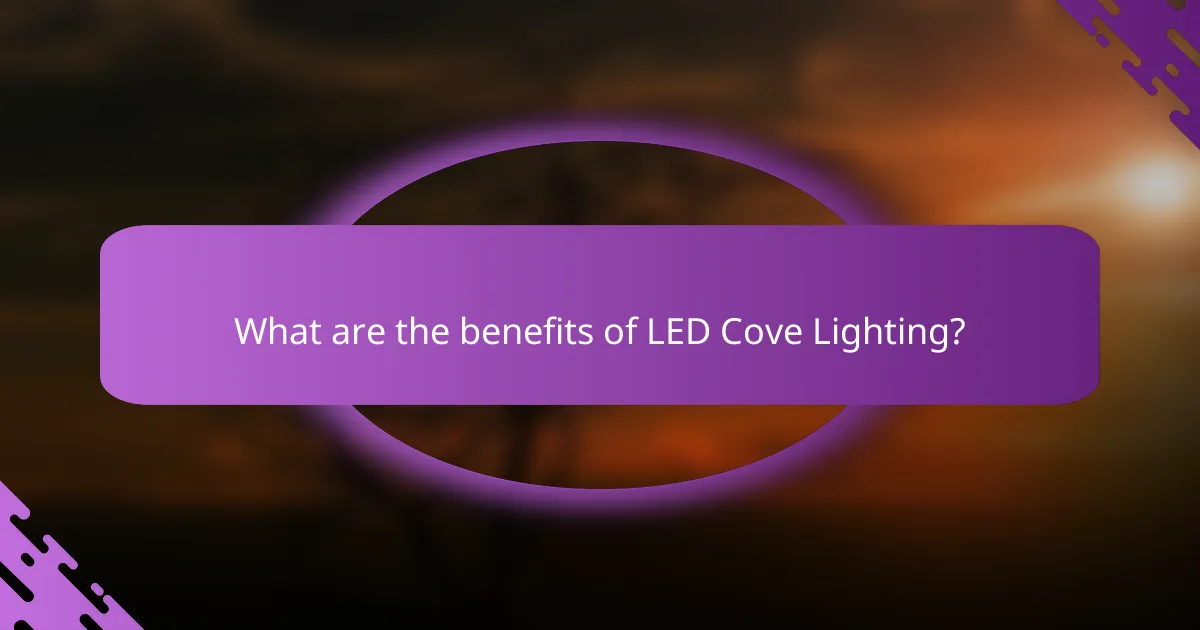Cove lighting is a sophisticated design element that offers a soft, indirect glow, enhancing the atmosphere of any space. By integrating hidden fixtures into architectural features, it creates a warm ambiance while maintaining a clean and unobtrusive look. This lighting technique not only elevates the aesthetic appeal of a room but also highlights its unique characteristics.

How does Cove Lighting enhance interior design?
Cove lighting enhances interior design by providing a subtle and indirect light source that creates a warm atmosphere while accentuating the room’s features. This type of lighting is often integrated into architectural elements, allowing for a seamless blend of functionality and aesthetics.
Creates a soft ambient glow
Cove lighting is designed to emit a gentle, diffused light that fills a space without harsh shadows. This soft ambient glow can make a room feel more inviting and comfortable, ideal for living areas and bedrooms. By using LED strips or fluorescent fixtures hidden in recesses, the light is cast upward against walls or ceilings, creating a soothing effect.
When selecting cove lighting, consider the color temperature of the bulbs. Warmer tones (around 2700K to 3000K) typically enhance relaxation, while cooler tones (4000K and above) can promote alertness, making them suitable for workspaces.
Highlights architectural features
Cove lighting effectively draws attention to architectural elements such as crown molding, coffered ceilings, or unique wall textures. By illuminating these features from above, it creates depth and dimension, making the design more visually appealing. This technique can transform ordinary spaces into extraordinary ones by showcasing their unique characteristics.
To achieve the best results, position the cove lighting to focus on specific features you want to highlight. Experiment with different angles and intensities to find the most flattering effect for your space.
Improves spatial perception
By strategically placing cove lighting, you can enhance the perception of space within a room. Indirect lighting can make ceilings appear higher and rooms feel larger, which is particularly beneficial in smaller areas. This effect is achieved by casting light upwards, which visually expands the vertical space.
Consider using cove lighting in conjunction with other light sources to create layers of illumination. This layered approach can further enhance spatial perception and create a more dynamic environment.
Increases visual comfort
Cove lighting reduces glare and harsh contrasts that can cause eye strain, making it a comfortable lighting option for various activities. The indirect nature of cove lighting creates a more uniform light distribution, which is easier on the eyes compared to direct lighting sources.
To maximize visual comfort, ensure that the brightness levels are appropriate for the room’s function. Dimming options can also be beneficial, allowing you to adjust the light intensity based on the time of day or specific tasks.

What are the best applications for Cove Lighting in homes?
Cove lighting is ideal for enhancing the atmosphere in various areas of the home by providing a soft, indirect glow. It works well in spaces where mood and functionality are essential, creating a warm ambiance while concealing fixtures for a clean look.
Living room ambiance
In the living room, cove lighting can create a cozy and inviting atmosphere. Installing LED strips or recessed fixtures along the perimeter of the ceiling allows for a gentle illumination that highlights architectural features without being overpowering.
Consider using dimmable options to adjust the brightness according to the occasion, whether it’s a movie night or a gathering with friends. Pairing cove lighting with other light sources can enhance the overall effect, ensuring a balanced and comfortable environment.
Bedroom relaxation
Cove lighting in the bedroom promotes relaxation and tranquility. By placing fixtures above headboards or along the ceiling, you can achieve a soft glow that helps create a peaceful retreat.
Using warm color temperatures, such as 2700K to 3000K, can further enhance the calming effect. Incorporating dimmers allows for customization, enabling you to set the perfect mood for winding down at the end of the day.
Kitchen task lighting
Cove lighting can also serve a practical purpose in the kitchen by providing essential task lighting. Installing cove fixtures above countertops or islands ensures that work areas are well-lit without harsh shadows.
For optimal functionality, consider using brighter LED options, around 3000K to 4000K, which can help with food preparation and cooking tasks. It’s important to balance this with other lighting sources to avoid over-illumination and maintain a welcoming atmosphere.

What types of fixtures are used in Cove Lighting?
Cove lighting typically utilizes fixtures that provide indirect illumination, enhancing the ambiance of a space while remaining discreet. The most common types of fixtures include LED strip lights, recessed lighting fixtures, and light tubes, each offering unique benefits and considerations for design integration.
LED strip lights
LED strip lights are flexible, low-profile fixtures that can be easily installed in cove spaces. They emit a soft glow and are available in various color temperatures, allowing for customization to match the desired mood of the room.
When using LED strip lights, consider the brightness level and color options. A common choice is to use warm white for a cozy atmosphere, while cooler tones can create a more modern feel. Ensure the strips are rated for the intended environment, especially in areas with high humidity.
Recessed lighting fixtures
Recessed lighting fixtures are installed into the ceiling, providing a clean and unobtrusive look. These fixtures can be used to highlight architectural features or artwork while contributing to the overall cove lighting effect.
When selecting recessed fixtures, pay attention to the trim style and beam angle. A wider beam angle can create a more diffused light, while a narrow angle focuses illumination on specific areas. It’s essential to choose fixtures that are compatible with dimmer switches for adjustable lighting levels.
Light tubes
Light tubes, or tubular skylights, are designed to bring natural light into a space, enhancing cove lighting with daylight. They consist of a reflective tube that channels sunlight from the roof into the interior, providing a unique and energy-efficient lighting solution.
Consider the placement of light tubes to maximize sunlight exposure throughout the day. They are particularly effective in spaces that lack windows, but installation may require professional assistance to ensure proper sealing and alignment. Keep in mind that light tubes may not provide sufficient illumination during cloudy days or at night, so they are best used in conjunction with other lighting fixtures.

How do you install Cove Lighting?
Installing cove lighting involves a series of straightforward steps that enhance the ambiance of a room while providing a soft glow. Proper planning and execution ensure that the fixtures are both functional and aesthetically pleasing.
Step 1: Plan the layout
Begin by determining the ideal location for your cove lighting. Consider areas where you want to create a soft glow, such as along the edges of ceilings or architectural features. Sketch a layout to visualize the placement of fixtures and the desired light distribution.
Ensure that the layout complements the room’s design and takes into account any furniture or decor that may obstruct the light. Measure the lengths of the cove to calculate the amount of lighting needed, allowing for some extra to accommodate any adjustments.
Step 2: Choose the right fixtures
Select fixtures that fit your design aesthetic and provide the desired light output. LED strip lights are a popular choice due to their energy efficiency and flexibility. Consider the color temperature as well; warmer tones create a cozy atmosphere, while cooler tones offer a modern feel.
Check the specifications for brightness and compatibility with dimmers if you plan to adjust the light intensity. Ensure the fixtures are rated for the space, especially in areas with moisture, where you might need damp-rated options.
Step 3: Install power supply
Before mounting the fixtures, install the power supply according to the manufacturer’s instructions. This typically involves connecting the power supply to your home’s electrical system, which may require a licensed electrician if you’re not experienced with electrical work.
Ensure that the power supply is appropriately rated for the total wattage of the fixtures you plan to use. It’s crucial to follow local electrical codes to ensure safety and compliance.
Step 4: Mount the fixtures
Once the power supply is in place, mount the fixtures securely along the planned layout. Use adhesive or mounting brackets as recommended by the manufacturer. Make sure the fixtures are level and aligned for a professional finish.
After mounting, connect the fixtures to the power supply, ensuring all connections are secure. Test the lighting before finalizing the installation to confirm that everything is functioning as intended.

What are the benefits of LED Cove Lighting?
LED cove lighting offers several advantages, including energy efficiency, design flexibility, and a soft, ambient glow that enhances the aesthetic of any space. It is an effective way to create a warm atmosphere while maintaining functionality.
Energy Efficiency
LED cove lighting is known for its low energy consumption compared to traditional lighting options. This efficiency can lead to significant savings on electricity bills over time, making it a cost-effective choice for both residential and commercial spaces.
Moreover, LED fixtures have a longer lifespan, often lasting tens of thousands of hours, which reduces the frequency and cost of replacements. This longevity contributes to lower maintenance costs and less waste.
Design Flexibility
One of the key benefits of LED cove lighting is its versatility in design. These fixtures can be installed in various locations, such as ceilings, walls, or furniture, allowing for creative lighting solutions that complement the overall decor.
Additionally, LED cove lighting can be customized in terms of color temperature and brightness, enabling users to achieve the desired ambiance for different settings, from cozy residential areas to vibrant commercial environments.
Soft Ambient Glow
The soft glow produced by LED cove lighting creates a welcoming atmosphere, making spaces feel more inviting. This type of lighting is ideal for areas where a relaxed vibe is desired, such as living rooms, restaurants, or retail spaces.
By strategically placing cove lighting, you can highlight architectural features or artwork without overwhelming the senses, enhancing the overall aesthetic appeal of the environment.
